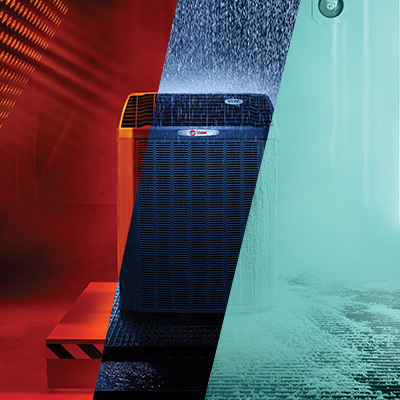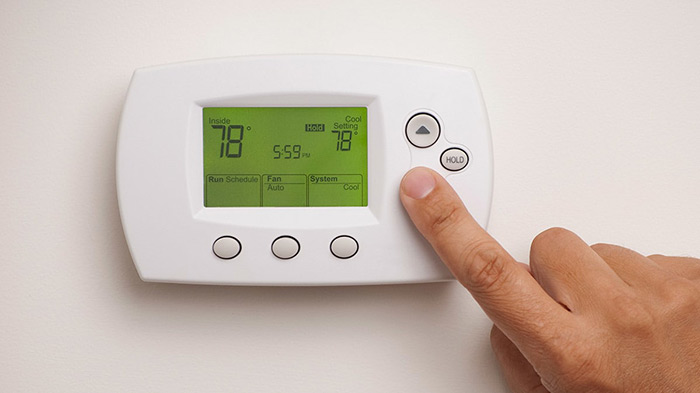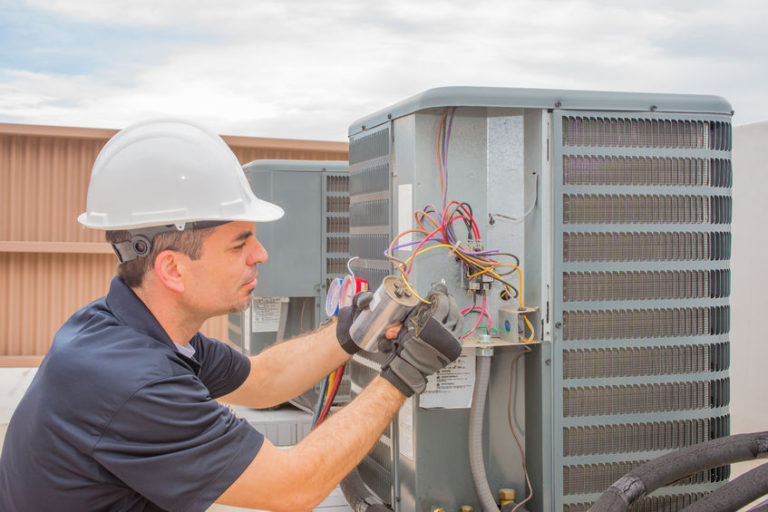Today, air conditioning is a staple of everyday life in New Jersey and much of the world. As of 1990, there were only about 400 million air conditioning units in the world, with most of them located in the US. It was originally intended for industrial use. The industry had struggled to convince the public that air conditioning was a necessity, until it began to enter people’s homes in the late 1940s, which began the air conditioner’s reign in the US. Here in the Ocean and Monmouth County area of New Jersey, it is hard to imagine navigating a summer without it. We depend on it to cool and climate-control our homes, office buildings, and automobiles. It’s not surprising that we often take it for granted.
View Our HVAC Services | Learn About All Air Systems
To those of us who love the cool comfort of air conditioning, it is often presented as a simple choice that consumers make to improve their lives. Not a luxury, but a necessity. We feel that everyone deserves AC. There are about 1.6 billion heating, ventilation and air conditioning (HVAC) units in the world, according to the International Energy Agency. This number will grow to 5.6 billion by 2030.

Call 732-888-0952 or Contact Us for a Free Heating and Cooling Quote in
Monmouth and Ocean County, New Jersey!
We appreciate that air conditioning is wonderful, but we should also realize the impact air conditioning has on the overall health of our planet. Air conditioners emitting harmful gases into the atmosphere which can negatively impact the environment the same way that other machines that burn fossil fuels do. Most air conditioners are fueled by electricity and use a refrigerant that results in a byproduct of gas emissions that cause climate change and deplete the ozone layer. In fact, some studies predict that by 2050, roughly 25 percent of global warming will be caused by air conditioning.
Humanity is caught in a feedback loop where warmer temperatures lead to more air conditioning and more air conditioning leads to warmer temperatures. The problem posed by air conditioning resembles, in miniature, the problem we face in tackling the climate crisis. The solutions that we are most likely to reach for only increase the likelihood of the original problem. The following are some of the ways that air conditioning is bad for the environment.
CFCs/ HFCs
Air conditioners are machines with different parts that work in several ways. CFCs and HFCs are both cooling agents used in air conditioners which create gas byproducts. In older air conditioners, this gas is very harmful and increases holes in the ozone layer when they are released over time. The current generation of refrigerants (hydrofluorocarbons or HFCs) has little effect on the ozone layer but unfortunately contributes heavily to the greenhouse effect. These leaky hydrofluorocarbons (HFCs) are thousands of times more potent that carbon dioxide.
We fixed the problem of CFCs (chlorofluorocarbons) impacting the ozone layer by banning their use, but HFCs have taken longer and are currently being phased out. The older fridges and ACs are more likely to be leaking the stuff, especially if they haven’t been maintained properly. But all of these HVAC units increase greenhouse gas emissions through increased energy use.
Energy use
Air conditioners require lots of energy to work well. Fossil fuels are rock-like, gas, or liquid resources that are burned to generate power. They include coal, natural gas, and oil, and are used as an energy source. They’re also a leading source of the world’s global warming pollution. Extraction processes can generate air and water pollution. Transporting fuels from the mine or well can cause air pollution and result in accidents and spills. When the fuels are burned, they emit toxins and global warming emissions. Even the waste products are hazardous to public health and the environment.
When fossil fuel is burned, carbon dioxide is released into the air, which is the most abundant of all the greenhouse gases. This is said to be a major contributor to ozone depletion.
Typical air conditioners consume 3000 to 5000 watts of electricity every hour they are used, depending on the season – the warmer the air, the more power they use. This is is extremely expensive, and unfortunately, very harmful to the environment.
Unclean ducts
It is important to note that air conditioners do not only affect the environment in a global way, it also affects it on a small scale as well. The ducts used in conjunction with your air conditioner collect dust and bacteria over time. Every time the air conditioner is turned on these are pushed through the home, which is unhealthy for humans, especially children.
Materials used
In the past air conditioners were mainly made out of metals. To reduce the weight of the units and the cost of production, manufacturers have transitioned most many air conditioner parts to be made of plastic. Both metal and plastic are harmful to the environment but plastic is not biodegradable and is less likely to be recycled and doesn’t last as long as metal. In fact, 50% of plastic is only used once, which makes it an enemy of the environment. The production of plastic alone is extremely detrimental, as it too releases carbon dioxide into the air and causes what we now know as the greenhouse effect.
That being said, in some places throughout the world, air conditioners can be vitally important for survival. Because of climate change, there are places that are extremely hot and people need to have cooling systems to live there. ACs may contribute to global warming, but we undoubtedly still need them in order to survive the rising temperatures, whether it’s at home or at work.
Air Quality
One of the main jobs of your air conditioner is to improve and maintain your home’s indoor air quality (IAQ), which is integral in promoting good health and quality of life. That’s why it is so very important to perform regular maintenance on your HVAC system. An easy – but crucial – place to start is by regularly changing air filters. Installing a home air purification system, humidifier or UV lights are also good options for improving IAQ. Call us today for more information on these products or to learn about our Energy Savings Agreement maintenance plan.
What can we do to reduce the impact?
Design neighborhoods with cooling temperatures in mind. Typically when suburban areas are subdivided and developed, trees get removed. Trees bring shade to footpaths and your yard, but they also reduce the heat load on a building. The natural cooling from trees is due to shade and transpiration that occurs when heat hits a tree’s leaves vaporizing the water in the plant and cooling the air below.
Walk barefoot across some concrete without shade to feel the effect, then move to an area that has shade because of nearby trees. An AC system works really hard to cool your hot house, if it’s located in full sun, it works even harder. Plant more trees, especially on the south side of your house if you are located in New Jersey, to increase canopy cover.
Alternative Power Source
On a regular day, New York City demands around 10,000MW every second; during a heatwave, that figure can exceed 13,000MW. That gap is the AC. The combination of high demand and extreme temperature can cause parts of the system to overheat and fail, leading to blackouts. In 2006, equipment failure left 175,000 people in Queens without power for a week, during a heatwave that killed 40 people.
It is important to reduce the carbon based energy used by buildings, especially because an increasing proportion of that energy consumption is being used by air conditioning. Renewable energy can offset some of the damage. Solar, wind and hydroelectric power are more available than ever before and have little to no negative environmental effects, harnessing the power of nature for clean renewable energy.
Solar panels provide clean, continuous energy with absolutely zero negative impact on the planet. Having these wired into your heating and air conditioning equipment could help save both money and the planet.
Insulation
Once developers could rely on maintaining comfortable indoor temperatures by using heating and cooling technologies, they often built less energy-efficient homes, which means that you rely more on air-conditioning or heating to get to your desired temperature.
You can maximizing its the effects of your HVAC system by addressing the efficiency of your home’s insulation. A badly insulated home bleeds energy and money and it is estimated that a well insulated home saves 1,500 times the energy of a non insulated one. Make sure your home’s insulation is effective and functioning in order to save the most possible energy and the planet as well.
Equipment
Air conditioners use a lot of energy and are responsible for about 6% of the energy use in the United States each year. That’s why one of the most important factors in the environmental impact of your air conditioner is your actual equipment. If you are using a faulty or outdated air conditioning and heating system then you probably aren’t being as environmentally friendly as you can. The newest model isn’t always required, but if you don’t know how old your system is, or if your equipment is more than four or five years old, an air conditioner upgrade will only help.
Obviously, air conditioning is not all bad. There are obvious benefits of a cooler, dehumidified air, as well as healthier and more comfortable living. Additionally, today’s air conditioners are much more efficient and less damaging to the environment than they used to be. Newer models use less energy and are fueled with safer, cleaner refrigerant. Air conditioning also impacts the environment in a positive way in the manufacturing world. Workers are much more productive in a climate-controlled environment, resulting in less wasted time and energy consumption.
New air-conditioner technology would be welcome, but it isn’t the most important thing we should rely on to reduce the emissions from air conditioning. Planting trees, retrofitting old buildings with proper ventilation, and building more efficient buildings that can better withstand a heatwave are Among the higher priorities.
Other ways to keep cool
Without building a new house or planting more trees, what can you do to keep cool in a more sustainable way?
When you come home from work and it’s stifling hot, try to use fans and windows to cool the house before you put the AC on. When you do use the air conditioner, make sure to shut all the windows and doors to seal the house.
The sweet spot for maximizing the efficiency of your air conditioning depends on a few factors.
If you have central air conditioning, consider installing a programmable thermostat that can allow you to set a different temperature when you’re away from home. You can keep the temperature higher when you’re at work or on vacation, saving you money on your monthly utility bills. This will allow you to keep it really cool when you need it, without wasting energy when you don’t.
Even just turning the temperature up a few degrees can make a big difference. You can save about 10% of your energy costs each year by turning your thermostat 7 to 10 degrees warmer for eight hours on hot days when your air conditioner would otherwise normally run. Your electric bill is tied to the amount of energy you’re using so you save money while doing your part to help the environment.
That said, we are over-reliant on air conditioning and could cut back. The ideal indoor temperature determined by air-conditioning engineers suggests that all humans want the same temperature range at all times. With an objective of comfort as the goal, this means that the temperature in most air-conditioned buildings is usually around 70 degrees Fahrenheit. In reality, everyone does not agree that there is a “right” temperature. Studies suggest that men have different ideal temperatures than women.
The best way to lessen your impact on the environment is to examine all aspects of your life, how much energy you consume and how much of it you can change or reduce. It’s our responsibility to take care of this planet as best we can so that it will last, and harbor life, for as long as possible.
HVAC REPLACEMENT
Good news: If your air-conditioner is working properly, it won’t release HFCs into the atmosphere. Unfortunately, there will come a time when it will become too costly to keep your old HVAC system running the way it should. Or perhaps its lifespan is nearing the end and replacing it is imminent. Either way, you can take comfort in the fact that a newer air conditioner will impact the environment much less than your old one.
New climate control systems can help drastically reduce energy usage and environmental impact by lessening or eliminating any pollution the system outputs as well as increasing energy efficiency. Call us at 732-888-0952 to get the information you need to know when updating your systems as well as helping you pick out and install the best one for you and your home.



